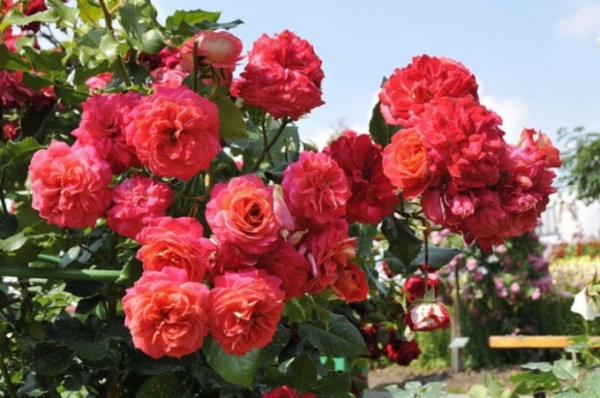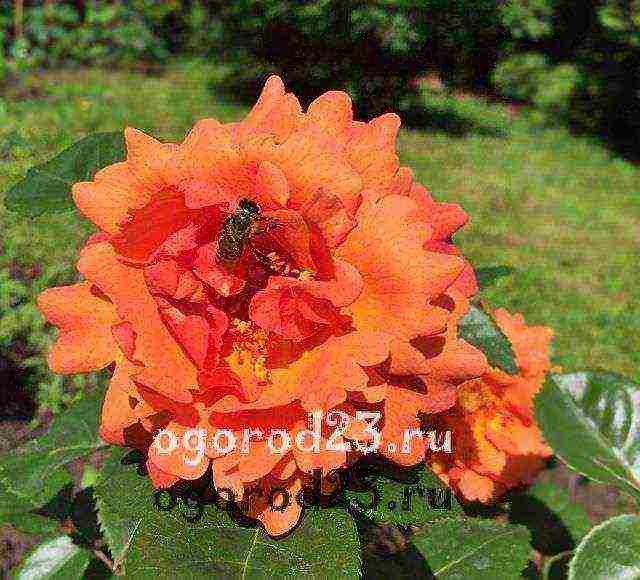Content
- 1 The best varieties
- 2 Main characteristics of Floribunda rose
- 3 Landing
- 4 Care
- 5 Protection against diseases and pests
- 6 Summary
- 7 Classification of varieties of roses. What types are there and how to distinguish between them?
- 8 Floribunda roses. Varieties, photos, description
- 9 Views
- 10 Care
- 11 Reproduction
- 12 Diseases and pests
- 13 Floribunda rose - photo
Floribunda rose is the result of long-term selection work. Back in the 1920s, Danish breeder Svend Poulsen began crossing large-flowered polyanthus roses with hybrid tea, then with hybrid polyanthus and other garden varieties. The result of a creative search was a hybrid called Floribunda, officially registered in 1952.... Since then, this unique group of roses has been leading its history. In the course of ongoing breeding, a huge number of varieties have been bred, differing in the color of the petals, the shape of the buds and the height of the bush. But they all correspond to the name of the group, which translates as profusely flowering.
The best varieties
Without exception, all varieties of Floribunda roses look gorgeous during flowering, and their aroma is difficult to resist. Among the variety of varieties, the most popular are worth noting:
Diadem
Floribunda variety Diadem (Diadem)
A popular, low-flowering variety. Dense double petals form a cupped bud. The color of the petals of a pale pink color gradually "fade" to almost white. The darker back of the petals contrasts with the lighter side, giving the flower a special effect. On the bushes, flower brushes are formed, 4-5 pieces in each... The foliage is dark in color and has good disease resistance. Diadem bushes are characterized by a compact shape and high winter hardiness.
Niccolo Paganini
Floribunda variety Niccolo Paganini (Niccolo Paganini)
It is considered one of the best flower bed varieties. The height of a compact bush with large dark leaves reaches 0.8 m. The petals are colored dark red, which does not change during the entire flowering period. From 5 to 12 buds are formed in the brushes, quickly opening and blooming for a long time, while maintaining their shape. The variety is suitable for both warm and temperate climates. It is distinguished by high winter hardiness and resistance to hot weather.
Carte Blanche
Floribunda variety Carte Blanche
Pure white goblet buds beckon with a rich aroma. Bushes 0.9-1.0 m high are covered with dark green glossy leaves... Flowers form clusters of 11-15 buds. Carte Blanche has good frost resistance.
Galaxy
Floribunda variety Gelaxi (Galaxy)
An erect, branched bush grows in warm climates up to 1.5 m. The color of the flowers, which is constantly changing, deserves special attention. The main color of the buds is creamy yellow with a reddish edge... In summer, the petals turn pale and become almost white, in autumn the color of the petals changes to pink. Flower clusters are formed from 3-9 buds.
Lilli Marleen
Floribunda cultivar Lilli Marleen
A compact bush 0.5 m high in spring is covered with reddish foliage, which later takes on a matte green color. Blood-red velvety buds when blooming form cupped flowers. Flower clusters are formed from 3-15 buds, not "fading" under the sun's rays. The subtle aroma of Lilli Marleen is well felt at close range. The variety is resistant to diseases, but needs preventive treatment against powdery mildew.
The varieties of the Floribunda group of roses can be listed for a long time, each of them is good in its own way and each is able to decorate any plot or flower bed.
Main characteristics of Floribunda rose
Rose Floribunda has become a favorite and popular among domestic gardeners due to its wonderful qualities. These include:
- beautiful scent;
- abundant and long bloom;
- large color choice and shapes of buds;
- unpretentiousness in care;
- steadiness to disease;
- high winter hardiness.
The latter quality is especially appreciated in our latitudes, because the plant is not afraid of frosts and tolerates Russian winters well, and if it does suffer, it recovers much faster than other varieties of roses.
 Floribunda rose color
Floribunda rose color
Floribunda roses are propagated by grafting or cuttings... Experienced gardeners can grow a rose from seed, but this is a troublesome task, the result of which will not be seen until a few years later.
Roses of this group are bred for bouquet cutting and to decorate the garden area. The versatility of the plant allows it to be grown outdoors, in greenhouses and even flower pots.
The main advantage of the Floribunda group is considered to be abundant flowering throughout the summer. Simple, double and double flowers are collected on the bushes in lush brushes up to 10-12 pieces, giving the bush a special decorative effect. The variety of colors allows you to create spectacular compositions both in single-varietal plantings and in combination with other flowering and decorative deciduous plants.
Landing
Before planting a Floribunda rose on the site, it is worth making sure that there is a suitable place for it. These plants need a lot of sunshine, but bright sun all day long will not work.... It is advisable to choose a site where, in the midday heat, the bushes can be in the shade, otherwise the roses will quickly fade.
Plants planted on the south side of buildings or fences will suffer from sunburn, and near the corners of buildings and in the aisles between them - from drafts.
Floribunda roses are preferable to plant in the spring, but this can be done in the fall. Gardeners of the middle lane should be guided by the approximate planting dates for their latitudes.:
- from late April to late May;
- from early September to mid-October.
 Before you start planting roses, you must first prepare the ground for this.
Before you start planting roses, you must first prepare the ground for this.
When choosing a grafted rose seedling, pay attention to the root collar. Its diameter should not exceed 5-8 mm. The seedling should have 2-3 lignified shoots, covered with intact green bark, and a developed root system with a sufficient number of thin roots.
The soil for Floribunda roses is prepared in advance. A sandy-clayey soil with a high humus content is considered optimal. When preparing the site for planting, the site is dug to the depth of the shovel and compost and phosphorus fertilizers are applied. Landing is carried out as follows:
- Sapling shoots are cut to 35 cm, the roots are shortened to 25-30 cm.
- Preparing the landing pit, a mound is poured from the soil mixture into the center of the pit.
- Lower the seedling into the hole, carefully straightening the root system on the surface of the mound.
- Planting depth is determined by the site of vaccination - it should be 3-8 cm deeper ground surface.
- Cover the roots with soil mixture, tamp with hands and watered.
- Escapes pruned to 2-4 buds.
- The first time after landing shade the plant from the midday sun.
Further Floribunda roses can be propagated by cuttings, which are first kept in a root formation stimulator, and after the roots appear, they are planted in open ground or a flower pot.
Care
Proper care consists in watering, loosening, mulching, feeding and shelter for the winter.
Watering
Watering for roses plays a big role, especially during intensive growth, when plants form young shoots, leaves and flower buds. Lack of moisture will negatively affect the decorative effect of flowers.... Water the plants regularly and abundantly, at least once a week. For irrigation, use warm, settled water.
 Watering these roses requires regular and abundant watering, especially in the hot season.
Watering these roses requires regular and abundant watering, especially in the hot season.
It is best to moisturize the soil in the evening by directing the stream to the base of the bush. In addition to traditional irrigation, sprinkling is used.
When sprinkling Floribunda roses, choose the morning or evening hours so that before nightfall the moisture has time to evaporate from the foliage, otherwise the development of fungal diseases is possible.
Loosening and mulching
Loosening is a necessary procedure that provides the roots with sufficient air and life-giving moisture. The soil under the bushes is loosened to a depth of no more than 10 cm, otherwise there is a risk of damaging the sensitive roots.
It is useful to mulch the soil with a suitable organic material in a layer of about 8 cm. This will keep moisture in the soil and prevent weed growth.
Top dressing
Floribunda roses will not be able to show all the beauty of flowering without additional nutrition. If, when planting the plant, the required amount of nutrients was laid, then in the first year after planting the bushes are not fed.
 After pruning, the flower must be fed with mineral fertilizers.
After pruning, the flower must be fed with mineral fertilizers.
Starting from the second spring, roses need regular feeding, the amount of which can reach 5-7 per season. The first feeding is carried out in early spring, the second - when the first buds appear, further - with an interval of 1-1.5 months.
For feeding, I use complex fertilizers in the form of a solution of 30 g of fertilizer and 10 liters of water. Pour 3 liters of nutrient solution under each plant always on damp ground - after watering or rain. In the fall in late October - early November, potash fertilizers are applied without chlorine in a dry form, scattering them over the surface.
Shelter for the winter
When growing roses in the middle lane, Floribunda rose bushes are covered for the winter. Pre-remove the remaining inflorescences and leaves, carry out sanitary pruning and shorten the shoots to a height of 0.4 m... Then they huddle up to 0.2-0.3 m with earth and cover with spruce branches or non-woven covering material in case of a winter with little snow. The snow that has fallen will cover the bushes with fluffy caps, and then the frosts will not be terrible for the plants.
Pruning
For Floribunda roses, regular pruning is an important maintenance item. It is held twice a year - in spring and summer. The main formative is the spring pruning of bushes. The abundance and duration of flowering of garden beauties depends on how correctly it is carried out. To enjoy fragrant flowers all summer long, follow the basic pruning rules.:
- Start spring pruning after warm weather sets in, since young shoots that begin to grow actively may suffer from frost.
- Necessarily remove branches older than 2 yearsas well as thin, dry and damaged.
- Trim the top of the bush, shorten the lateral processes on the main shoot.
- Leave 3-5 strong and strong shootscutting out completely old shoots in the middle of the bush.
- With medium pruning leave 4-6 kidneys, at low - 3-4 kidneys.
- Do a cut above the upper kidney by 1 cm... At the same time, the bud should be on the outside of the shoot, then the bush that has grown subsequently will look more spectacular.
- Make oblique cuts for free drainage of water, after pruning, cover them with garden pitch.
If the Floribunda rose is not trimmed or trimmed lightly, it will grow into a large bush with weak stems. Correctly done spring pruning stimulates the plant to form lush flower clusters with a lot of buds., which will begin to open in June. Pruning in summer will prolong the flowering of the rose bushes. In the fall, only sanitary pruning is carried out.
Protection against diseases and pests
Floribunda roses are susceptible to attack by insects and fungal infections. Dangerous for flowers are rose sawfly, spider mites, aphids, rose leafhoppers and leafworm... For pest control, ready-made insecticides are used, since there is a great choice of them. Preventive treatment of plants in early spring is useful.
Rust, powdery mildew, leaf spot and gray rot are more common fungal infections on rose bushes. The infection can be stopped by removing all affected leaves and shoots, treatment with iron vitriol or Bordeaux liquid... It is also recommended to use fungicidal preparations.
Summary
Floribunda is an unpretentious plant. The varieties of this particular group are recommended for inexperienced gardeners to comprehend the intricacies of growing garden roses. Bushes of different heights will create magnificent curbs or hedges on the site, they will be effective in group or single plantings... Correct pruning and regular application of complex fertilizers will ensure abundant flowering throughout the summer, which will delight the owners of the site and attract the attention of passers-by.
Summer residents and gardeners love to decorate their backyards with flowers. In many courtyards, you can see large flower beds and flower beds. Some people even create indescribable beauty from flowers, forming flower beds of continuous flowering. One of the main beauties is the rose. She is rightfully considered the queen of the flower world. It is she who, to a greater extent, is given special preference by both amateur gardeners and professionals. Therefore, many people want to choose the best varieties of roses. How to make the right choice and what should be considered?
The main criterion for the abundant flowering of the bush is the environment and soil characteristics. As many gardeners note, no matter which variety of roses is chosen, you can create a fertile soil for it yourself and concentrate the beds anywhere you want. Thus, the problem with the difference between the flowers you like and the soil conditions unsuitable for them is solved.
Roses with so-called complex colors are very demanding to the composition of the soil. The petals of such flowers have a combination of several shades. They can be very different and combine smooth or sharp transitions. Modern breeders have learned to breed amazing species of this plant, which have not only a complex coloring, but also an incredible shape. On unsuitable soil, such plants acquire a depressed state, an unsightly shape and a dull color. Their life cycle is significantly reduced.
Very often people choose David Austin roses. The varieties of these flowers are intended mainly for cultivation in partial shade and in loamy soils. Such conditions are typical for many other species. If we consider in general the soil conditions and the location of the flower bed, then these flowers love light breathing earth. It is categorically impossible to plant seedlings in clay, sandy and sandy loam soil, since it poorly permeates moisture and, practically, does not allow air exchange between the root system and the soil. Experts recommend, in this case, to carry out a double digging with the addition of chernozem, peat, sod land and well-rotted manure. In this case, the proportions should be kept approximately equal.
The best place to plant roses is on the southeast side of your patio, garden, or backyard. The place should not be dark, shaded by buildings, trees or ornamental shrubs.
As for the climate, then one should take into account the resistance of a particular type of plant to changeable weather conditions, to cold, heat and lack of air humidity. Are absolutely contraindicated for the colors of the place of north-western orientation at the summer cottage. Plants are very sensitive to drafts and cold winds, so roses will not grow well in such areas.
Classification of varieties of roses. What types are there and how to distinguish between them?
The opinions of many experts and florists boil down to the fact that before you start growing these beautiful flowers, you need to find out as much information as possible about them in order to avoid mistakes. After all, in the end, every grower, regardless of qualifications, wants to get high-quality, fragrant and beautiful roses. Species and varieties are divided into several categories. In each of them, there are the best options that have proven themselves positively in all respects.
The most beautiful and common types of roses are:
- Floribunda.
- Hybrid tea.
- Grandiflora.
- Groundcover.
- Climbing.
- Shrubs.
- Selected by David Austin.
When choosing a variety, you must take into account your preferences and tastes, then your favorite flowers will appear on your personal plot.
Floribunda roses. Varieties, photos, description
The history of these flowers began in 1924, when the Danish originator by the name of Poulsen first bred the original flowers of this type, which were called hybrid-polyanthus. At first, they belonged to the general category of tea roses, and were bred into a separate group in 1976. Some experts note that floribunda roses are intermediate varieties between the two types (hybrid tea and climbing). A distinctive feature of these colors is the diversity in everything. This is especially true for the combination of shades and tones. As a rule, they are rich, colorful, juicy.
General characteristics. The height of the bushes varies from 40 cm to 1.5 m, about 35 inflorescences can be collected on one stem. The flowers themselves have from 8 to 24 petals, the edges of which are distinguished by medium doubleness. In shape, some varieties resemble a narrow or wide glass, while others can bloom with flat or cupped buds.
The description of floribunda rose varieties also shows that their individual specimens can have golden clear shades, which are distinguished by a glossy surface and rigid petals. Such plants have an average height (about 1 meter). They are also characterized by larger flowers, which are collected in small inflorescences.
It should be noted that floribunda is a continuous flowering rose. They are also resistant to frost, fungal and viral diseases. This is an excellent solution for decorating your summer cottage or home yard.
The best floribunda roses, varieties with photos:
- Golden Vedding (Golden Wedding) German selection.
- Samba. Germany, selection W. Kordes.
- La-Paloma (La Paloma). Germany, breeding Tantau
- Lion-Rose. Germany, selection Kordes.
- Leonardo da Vinci. France, breeding Meilland.
- Tchaikovcki. France, breeding Meilland.
- Gebruder Grimm. Germany, selection Kordes.
- Pomponella. Germany, selection Kordes.
- Jubile du Prince de Monaco. France, breeding Meilland.
- Koncerto (Concerto). France, breeding Meilland.
- Purpl Tiger (Purple Tiger). France, breeding Meilland.
Hybrid tea roses: varieties, photos, description
This group has a very interesting history. Back in 1867, the Frenchman J.-B. André Guillot was engaged in the cultivation of flowers that were unique at that time. For years he experimented with La France, crossing remontant and tea roses. As a result, he created a wonderful plant that had many differences and its own unique zest. Then André Guillot positioned his brainchild as a variety of bourbon roses.
In the description of varieties of hybrid tea roses, their main feature is listed - the continuity of flowering. Also characteristic of these flowers are easily-cranked or straight stems, which have increased strength. They create erect, slightly spreading shoots. The varieties of hybrid tea roses were classified into a separate group in 1997.
The bushes are characterized by low shoots. Their length is a little less than a meter, they have large racemes with 4-7 leaves. Most often, flowers are collected in small inflorescences of 4-6 pcs. The shades are very different (in some varieties, several colors can be combined). There are new varieties of hybrid tea roses that have complex large double flowers.
Almost all varieties of hybrid tea roses have a beautiful appearance and are perfect for decorating not only a summer cottage, but also premises. The average period of initial, active flowering lasts about a month.Then comes the time to move to the next stage - the emergence of new flowers (15 days for early varieties and 30 days for later). Then they bloom continuously until the first frost.
The best varieties of hybrid tea roses:
Medium-sized varieties:
Red-pink varieties:
Rose varieties of the Grandiflora group
A relatively new type of flowers, developed for decorating gardens. They look like a low-growing tree, about 1.5-2 m high. This group of flowers was obtained by crossing floribunda and hybrid tea varieties. Grandiflora embodies the best qualities of these varieties. They have a very attractive appearance and have a wonderful aroma. Notable properties are resistance to disease and frost.
The best varieties of Grandiflora roses:
Ground cover roses: varieties, photos, description
The name of this group contains the main answer to the question about the main characteristics of the plant. Groundcover - low-growing roses that are able to cover a vast area of the flower bed with long shoots with many flowers blooming on them. The length of the shoot can at times reach up to 4 meters. Thus, nature creates a natural, beautiful carpet.
There are also ground cover roses, varieties of which, in addition to creeping on the ground, shoot drooping shoots. This type of growth provides an indescribable beauty to the bushes. Some species bloom once a year (they are rarely used by summer residents). It is the continuously flowering varieties of ground cover roses that are very popular.
Roses also have ground cover varieties (see photo), which are characterized by a variety of shades (light pink or pale crimson, red and dark red, light red or pure white). The buds have a variety of sizes.
Another feature of these flowers is frost resistance. Many varieties do not shed their foliage until spring. They are good for decorating columns or walls in the yard. Despite this, the base of the plants should be covered for the winter.
Ground cover roses, winter-hardy varieties (photo):
Roses shrabs: varieties, photos
Speaking about this group of flowers, one can note their main feature - a magnificent aroma, neat, upright bushes, abundant and continuous flowering. Flowers can be of various shapes (there are small ones, and there are large ones, the diameter of which reaches 12 cm). Petals are double, semi-double or simple. The leaves do not have a glazed surface; they can be dark green with a burgundy tint.
It should be noted that shrub roses were introduced into a separate group in 1954. It was then that many very beautiful species of this plant appeared.
Due to its structure and powerful root system, the formation of a bush is very easy, the main thing is to cut it on time. For example, flower growers very often form a ball, cone or strict square. This is not difficult to do. Some summer residents use this plant to form a decorative hedge to highlight one or another area of the personal plot.
Roses are grown shrabs (see varieties with photos) summer residents, both in separate flower beds, and in combination with other types of flowers. They are often used in the planning of gardens or parks, which is why shraba roses are called landscape or park roses.
There are three groups of scrub (park) roses:
- Curly - the length of the shoots is from 5 to 16 m.
- Climbing - the length of the shoots is up to 6 m.
- Semi-plaited - the length of the zero shoot reaches a little more than 3 m.
Erect bushes can reach heights of up to one and a half meters. Among the advantageous properties is frost resistance (especially Canadian park roses, the varieties of which can withstand a temperature drop of up to 350 C of frost). They bloom all summer until late autumn continuously, delighting the eye with their indescribable beauty and aroma.
The best varieties of scrub roses:
Roses bred by David Austin
The origin of this group of flowers is very interesting.An English breeder named David Austin began breeding completely new types of roses. He experimented for a long time, crossing classic floribunda and tea hybrid with varieties of long-forgotten old French and Damascus roses, which have already lost their popularity and demand among gardeners and summer residents.
As a result of his hard work, flowers of a completely new format were obtained, which began to be called Austin roses. The varieties he bred have very attractive shapes, with intricate petals and the structure of the bud itself. They are also characterized by new aromas. Many experts compare the smells of these flowers with the aromas of expensive, natural and real teas.
The best varieties of Austin roses are very beautiful and are often grown for the trade. Despite the variety of forms of shoots, bushes and an abundance of flowering, the presentation of all varieties of rose leaves is not lost.
The work done by the English breeder has a great price. For example, breeding a single resistant variety requires 4 to 8 years of diligent attention and careful approach. Austin devoted his whole life to this business, which is more than 60 years. From a very young age, he started a business that brought him the most pleasure. The nursery he created, which is located in Shropshire, is still engaged in the development of new types of Austin roses. The catalog of varieties with photos is constantly updated with new types of these flowers, which have incredible beauty and advantageous properties.
It should be noted that the climatic location of Shropshire (western part of England) contributes to the endowment of Austin flowers with unique properties - resistance to severe weather conditions and diseases.
Austin roses, photo varieties:
Climbing roses: continuously flowering varieties
According to the description and characteristics, the budding and flowering phases of these beautiful plants are very extended. Shoot formation occurs constantly. This property contributes to the continuity of flowering. This period can last up to six months without interruption. Paying attention to this feature, many designers and flower growers use them to decorate complex and simple building elements of their homes and courtyards. The best, in this regard, are Climings or Banks.
Also, varieties of climbing roses that grow all summer can be divided into three groups according to the nature of growth:
- Curly. The length of the shoots is up to 15 m.
- Climbing. Shoot length up to 5 m.
- Semi-plaited. The length of the branches does not exceed 3 m.
This classification is not accidental. The fact is that claimings bloom on young shoots, and ramblers use branches from past years. The approach to plant breeding and the formation of a beautiful, climbing bush depends on this nuance.
The most beautiful varieties of climbing roses:
This article provides a description and photo of the most popular, beautiful, fragrant and original varieties of roses. Therefore, flower growers and summer residents have a good opportunity to purchase those flowers that best suit his tastes and requirements.
Content
- Views
- Care
- Reproduction
- Diseases and pests
In nature, the floribunda rose has never existed. The flower was obtained by the Dane Poulsen, who crossed a large-flowered polyanthus rose and several varieties of tea roses. The resulting hybrid acquired the durability of the former and the beauty of the latter. Further selection work made it possible to create various varieties of floribunda roses, which are successfully cultivated in our gardens.
Floribunda rose - a true queen in your garden
Luxurious pale coral floribunda
Soft cream dressy floribunda rose
Scarlet splash of passion - bright red floribunda rose
Luxurious floribunda of the Bonfire variety
Incredibly delicate white floribunda rose
Hot pink floribunda with a pale yellow center
Views
Admiring the variety of colors and the subtle aroma of the floribunda rose, gardeners consider its main advantages to be abundant flowering, which lasts the entire summer season.In addition, the flowers of the rose are not scattered one by one on the bush, they decorate it, gathering in lush groups. For the temperate zone, special plant varieties have been developed, adapted to our climatic conditions.
Lacerose raffles floribunda won the hearts of gardeners with an exquisite flower pattern, the petals of which are intricately cut and assembled into delicious lace. Large, up to 8 cm in diameter, flowers shine on the bush from the first days of summer until late autumn. For proper development, it is necessary to cover the plant for the winter. Apply the variety in curbs and flower beds.
Rose des Cisterciens lace floribunda
Luxurious beauty of the Cherry girl variety
Incredible Amber Queen rose
Luxurious delicate flower of Easy Does It variety
Floribunda of an incredible lilac color of the Angel face variety
Haveroses floribunda kimono peach shades of flowers are appreciated. The light haze of their pink-orange range looks great against the background of red and white flowers of other plants, but this variety is surprisingly decorative in solo performance. It fits perfectly into the rose garden and forms into a beautiful flower bed.
Large-flowered floribunda kimono in lovely pink-peach color
Floribunda Kimono in garden decoration
If you are an adherent of red lights in the garden, thenrose floribunda nina weibul will blaze with scarlet fires until the first snow. This variety has good health and excellent resistance to midwinter winters. From roses floribunda nina beautiful borders are obtained, compact and brightly blooming.
A bright flash of color - floribunda rose Nina Weibul
Scarlet Tale in Your Garden - Nina Weibul
Chicrose floribunda rumba, with a low, half a meter in height, growth is distinguished by an amazing orange-red shade of flowers and the splendor of brushes. Up to fifteen magnificent flowers, up to 6 cm in diameter, can bloom in one brush.
Fiery Beauty - Rose Floribunda Rumba
Solar Rumba in the flowerbed
Whichever floribunda variety you choose, they will all reward you with an impressive bloom, but it takes a little work to get there.
Care
Having looked at the wonderful photos flower, the question arises of how to plant and care for a floribunda rose so that such splendor will grow in my garden. Consider the requirements of a flower for proper planting and further care of the plant.
Scentimental variegated flower
A touching and sensual floribunda rose Bluebird
Beautiful salmon floribunda
Temperature
Since most of the floribunda varieties sold in our stores are already adapted to temperate climates, temperature plays a role only in cold weather and during planting. Experts recommend planting a flower in late spring, when the soil has warmed up and the air temperature does not threaten minus degrees. For the winter, it is better to cover the rose bushes well, in order to avoid their freezing.
Floribunda will give your garden a truly luxurious look and wonderful aroma
Caramel Antike with a delicious caramel shade
Sunny yellow floribunda
A bush of a delicate white rose floribunda in a flowerpot near the house is a wonderful decoration for the entrance to the house
Illumination
Before purchasing floribunda rose seedlings, make sure there is an area on your site that is open to sunlight and protected from drafts. The flower loves good light and suffers from the winds blowing through the planting.
Please note that even the slightest darkening will negatively affect the growth and flowering of the plant. Plant flowers away from trees and fences.
Gorgeous fragrant Carol rose
The soil
When the seedlings are purchased, we proceed to the preparation of the site. The pits for each plant should be wide, because the floribunda rose has a very branched root system. For planting, we mix garden soil with peat, humus, sand and weathered clay. This combination provides an ideal substrate for growing floribunda roses.
Advice! For rapid growth and development, add bone meal and some fertilizer to the prepared soil.
Bright rose of the Midsummer variety
Love song magic rose
The most delicate coral rose floribunda
The luxury of Gold Marie
Flowers of a deep burgundy color of the Burgundy Ice variety
Top dressing
In order for the plant to retain the saturation of shades for a long time and develop well, periodically feed it with urea, saltpeter and potassium fertilizers. It is even better if you apply an alternation of fertilizing with mineral and organic (compost, humus) fertilizers.
Watering
Keep watering at a moderate pace and volume. Water the flowers as the top layer dries, but in small portions to avoid flooding the roots.
Delicate flower of the Leonardo da Vinci variety
Floribunda of a beautiful juicy color, cultivar Planten un Blomen
A flash of sun on a flowerbed - a floribunda rose cultivar Arthur Bell
Pruning
One of the most important maintenance points is the correct pruning of all varieties of floribunda roses. You cannot mercilessly shred the shoots in the hope that this is useful for the plant. Only 4-6 upper buds are enough to remove for the floribunda to bloom luxuriantly and retain a good decorative shape. Pruning is carried out during the growing season of the plant, at the stage of the formation of new shoots.
Important! Periodic summer pinching of the bushes will provide you with a long flowering of the rose, giving the opportunity to form new inflorescences.
Fragrant "field" of many beautiful roses
The beauty and variety of floribunda attracts and enchants
Stunning garden decoration - floribunda rose hedge
Reproduction
The main method of propagation of floribunda roses is considered to be cuttings. Lignified shoots are chosen for cuttings. The cut branch is divided into parts, each 8 cm long, with the expectation that the cut of the top of the cutting is 0.5 cm from the bud.
Important! The upper cut of the cutting is made at a right angle, and the lower one is cut at 45 degrees.
Having freed the lower part of the cutting from the leaves, it is dug into the soil up to half the length. The finished cuttings are placed in the soil at a distance of 15 cm. Then the planted parts are covered with a film. For proper rooting, a small greenhouse must be ventilated, and the cuttings must be watered regularly. If the cutting is producing a bud, it should be removed to allow the plant to form a good root system. In this state, the cuttings should spend about two years before they become ready-made seedlings.
Bright, attractive floribunda flowers of the Livin 'Easy cultivar
Angel face beauty
A delicate rose will adorn any unsightly garden element
Diseases and pests
The main pests of the plant include rosacea aphids, spider mites and gall mites, leafworms and leafhoppers. Dangerous for the floribunda rose and diseases such as powdery mildew, gray rot and rust.
Rose aphid attacks young leaves, buds and shoots, sucking juices out of them. It reproduces well and quickly kills the plant if it is not destroyed in time. To combat it, the treatment of bushes with karbofos or the Iskra preparation helps.
Do not forget to treat plants with pest drugs in time.
A garden full of floribunda roses of different varieties
The leafworm eats up the edges of the leaves, exposing the entire bush. It can also be destroyed with Iskra.
If the buds and leaves of the plant are covered with a white bloom, it means that the plant has been affected by powdery mildew. Pruning of the affected areas and treatment with copper sulfate and Topaz will help to cope with it.
Rust leaves orange-yellow pads on the leaves and shoots. You can destroy it with the help of the drug "Hom".
If you provide the rose bush with all the conditions that are important to it, then a fragrant rabatka or a colorful border of lush blooming and bright roses will appear on your site.
To learn more about the floribunda rose, planting and caring for it, the video will help you:
Floribunda rose - photo
Floribunda roses - what are they? Look at the photo and you will agree that the Latin word "floribunda" is translated as "profusely flowering roses." This is indeed the case. Any variety of these flowers is characterized by abundant and prolonged, almost continuous flowering. They are resistant to cold, to most diseases inherent in roses. These are special representatives of the rose family, which are distinguished by their sophistication and decorativeness. Perhaps it is difficult to imagine a favorite garden or summer cottage without these luxurious, beloved flowers.

↑ back to content ↑ Floribunda roses - description of the peculiarities of the variety
Back in 1924, Danish breeder Svend Poulsen bred the first hybrid rose cultivar. By crossing tea, nutmeg and polyanthus roses, floribunda was born, which combined all the best qualities of the "parents". The shape of the buds, their size, a rich palette of shades were borrowed from hybrid tea roses, and the cold resistance and good immunity of the floribunda were taken from the polyanthus representatives. Today, many varieties of these roses have been bred, this type is extremely decorative: lush buds are "classic", goblet or in the shape of a cup, they can have semi-double, double or ordinary petals. Its inflorescences can be of various sizes. The height of rose bushes varies from 30 cm to 1 meter (and more), flowering lasts throughout the summer. Faded buds are replaced by blossoming ones, and you can admire this beauty until the onset of autumn.
What is the difference between floribunda roses and hybrid tea? These two species are very similar to each other, both are characterized by long flowering, however, the hybrid tea rose gives a wave-like color, and the floribunda blooms continuously. Despite the lush beauty of the floribunda, in fairness it is worth noting that it is still somewhat inferior to the hybrid tea in terms of decorative qualities. With regard to disease resistance, care requirements and growing conditions, here the floribunda is a stronger representative. The shoot of the hybrid tea rose is crowned with one luxurious bud, while the stem of the floribunda has many inflorescences (up to 10-12 flowers).
Floribunda rose, photo:
If desired, floribunda can be arranged in the form of a lush bush, planted in an appropriate pot or flowerpot, and turned into a standard tree.

From roses of this type, hedges, borders are obtained, garden paths are made out. In a single fit, they also look impressive and elegant. Floribunda feels great after cutting, with its help all kinds of festive and even wedding bouquets are made. These flowers love sunlight and warmth, do not react well to drafts, but, in principle, planting and caring for floribundas is not very different from gardening concerns with ordinary rose bushes. Thus, knowing the simple rules, even a novice gardener can grow a beautiful floribunda.
↑ back to content ↑ Planting floribunda roses - terms, place, soil
The optimal time for planting roses is May or June, however, residents of warm regions of our country can do this in September or mid-October. In advance, you should choose a calm place that will be illuminated for most of the day. There is a small nuance here - the area should be light, but the roses should not be in direct sunlight all day, because they will simply fade. Light shading is necessary, then the floribunda will bloom long and luxuriantly. You should also beware of drafts.
The composition of the soil is important: if clay soil prevails on your site, then dilute it with compost and river sand before planting roses. Also, bone meal and superphosphate (40 g per hole) can be added to the soil mixture. With sandy soil, you should do the same - dilute, add clay in half with humus.Or, you can pre-prepare a composition of equal shares of peat, sand, humus, clay and garden soil, to which you need to add a handful of bone meal and superphosphate. A pit for a rose should have approximately the following dimensions: 50 × 50, depth - 30 cm.

Planting process:
- The roots and shoots of rose seedlings are cut to living tissue (if necessary). Even healthy fragments need to be trimmed, they are left at the roots - about 30 cm in length, at the shoots - 35-40 cm.
- It is necessary to immerse the roots of the seedlings in water in advance (for 24 hours). You can add a little Kornevin (the dosage is indicated on the package).
- A hole of the indicated dimensions is dug, at the bottom of which water is poured, after it is completely absorbed, a soil mixture (see above) with superphosphate is poured. Remember that the floribunda rose does not like tightness, so the seating area should be relatively spacious.
- A seedling is placed on the poured soil mixture - this must be done in such a way that in the "finished" planted form, the grafting site of the seedling is 2 cm above ground level.
- Further, the roots of the rose are sprinkled with earth, which is slightly compacted with your hands. The seedling is well poured with water, after it has been absorbed, it is covered with soil.
- From above, the soil can be mulched with peat, humus or sawdust. If the planting was carried out in the spring, but the sun is already beating down with all its might, form caps out of paper and cover the seedlings with them, do not remove this cover until the roses take root in a new place.
Floribunda needs abundant watering, fertilization, formative pruning, which is carried out during the growing season. In this case, the shoots are cut so that 6 buds remain on them, the side branches are also shortened. Dried and severely damaged fragments are also removed. In principle, neat formative pruning can be done throughout the season, and renewal, medium pruning with the onset of spring.
↑ back to content ↑ Floribunda roses - care and cultivation
Care is not complicated: loosen the soil in time, remove weeds, do not forget to mulch. The main focus of floribunda care is pruning. To the above information, it should be added that spring pruning is the main, formative and sanitary. Summer pruning aims to increase the flowering time of the rose. But in the fall, this process should not be carried out, so as not to weaken the plant before the coming winter.
Keep in mind that weak and poorly growing floribundas should be pruned more actively and stronger than powerful and strong representatives - this process activates the vitality of the rose, provokes the growth of new and renewal of old shoots. If you cut the bush very strongly in the spring, then flowering may come late, with the arrival of August or even September (in some varieties).
Floribunda rose loves abundant watering, with the arrival of summer heat, at least 10 liters of water must be poured under each bush. You need to do this once a week, but with the arrival of extreme heat, you can do it twice. The best time to water roses is early morning or evening, you should not do this on a sunny day. It is especially important to saturate the plant with moisture during bud and foliage blooming, as well as after the first flowers appear.
With the onset of autumn, watering becomes less frequent, especially when it rains.
As for fertilizers, during the active growth phase, it will not be superfluous to feed the plant with a nitrogen supplement or mullein (1 or better 2 times). By the end of summer, floribunda can be fertilized with a potassium-phosphorus supplement (for example, potassium nitrate, potassium sulfate, ammophos, superphosphate). Top dressing is applied as follows: grooves are formed around the bushes, they are poured with water, after the water is absorbed into the ground, it is the turn of liquid fertilizers, after which everything is again filled with water, covered with soil. Keep in mind that in the first year after planting, the bush is not fertilized with anything.
To prevent the appearance of fungi, until the buds on the rose bloom, it should be sprayed with Bordeaux liquid or a solution of copper sulfate.
Insecticides such as "Actellik", "Karbofos", "Rogor" will help from the invasion of pests.
For the winter, the rose must be covered, and before sheltering, cut off all the buds, remove the foliage and unripe shoots (they are red, not green). After that, the shrub is treated with Bordeaux liquid, and all removed plant fragments are collected and burned.
When trimmed, the floribunda bush should be about 30-40 cm in height.
For the winter, they huddle it up and cover it with peat or river sand, so that the plant is completely covered. For reliability, especially if the winter promises to be cold, you can additionally cover it on top with spruce branches. Or you can cover the bush with some special material (for example, lutrasil), and then additionally spud it with sand and cover it with pine or spruce branches.
↑ to the content ↑ Floribunda roses - varieties, photos, description
There are no ugly roses, some people like the same varieties more, some less. Calling a particular variety the most beautiful is a matter of taste, so here I will mention some of the most common species that our compatriots prefer to grow in their gardens and summer cottages.
↑ back to contents ↑ Floribunda Leonardo da Vinci
The variety is considered one of the most frequently planted in our country. These roses have rather large buds, the diameter of which can reach 10 cm. The goblet flowers are painted in a rich pink color, have a weakly pronounced delicate aroma, and a dense double shape. This variety looks equally good in single or mixed plantings, and it is also used to create standard trees. Floribunda "Leonardo da Vinci" grows up to 1 m in height, resistant to disease and rain.
Leonardo da Vinci variety:


↑ Back to Contents ↑ Floribunda Rose Acropolis
This variety has a unique petal color. At first, they have a pink tint, but over time, blooming more and more, they become coffee. The Acropolis bush grows up to 1 m in height, each bud is 4-6 cm in diameter. This rose is resistant to cold and disease, looks equally good in the garden and in a vase. When cut, retains freshness for a long time.
Variety "Akropolis":


↑ Back to Contents ↑ Rose Floribunda Raffles
It attracts attention with its large and lush buds, and the petals on them seem to be corrugated, cut at the edges. It looks unusual and exotic, the petals look delicate. Raffles can have a different color of petals, grows up to 40-60 cm, blooms profusely all summer until late autumn. This variety, alas, is vulnerable to diseases of roses - this factor must be taken into account when planting and caring for a plant. Bushes should be placed at a distance from each other so that they are well ventilated, because excessive thickening provokes the manifestation of diseases.
Floribunda Raffles:

↑ Back to Contents ↑ Floribunda Carte Blanche
The variety is tall, the foliage is very dense and decorative in its own way. Terry snow-white buds are of medium size, but abundant flowering and resistance to various "pink" diseases make this species one of the favorite among our gardeners. This rose grows up to 60-80 cm in height, blooms for a long time, like all its fellow tribesmen, until the coldest days.
Floribunda rose "Carte Blanche":


↑ back to contents ↑ Rosa Niccolo Paganini
This variety is called the ideal floribunda. Luxurious large bright red buds are crowned with upright shoots, which grow up to 70-80 cm in height. This rose is also used for making bouquets, flower arrangements, has all the "pluses" of floribund - cold-resistant, has strong immunity, its fragrant flowers do not fade in the sun. This variety is one of the first to bloom, 10-12 buds are formed in the inflorescence.
Floribunda rose "Niccolo Paganini":


↑ back to contents ↑ Rose "Blue for You"
The variety will surprise you with all shades of lilac and blue. This is an extremely decorative species, and the unusual color of the inflorescences only adds personality to it. The shape of the bud is remarkable in that even in the phase of its full disclosure, it remains, as it were, not fully opened. This is a real blue rose, with its own natural shade. The bush grows up to 80-90 cm in height, gives flowers until October inclusive, feels comfortable in partial shade, as well as under the bright sun. This variety is resistant to cold, practically not affected by diseases, reacts normally to precipitation.
Floribunda rose "Blue for U":



↑ back to contents ↑ Floribunda "Easy Does It"
The variety is famous for its bright, rich orange flowers that have a delicate, slightly fruity aroma. It is noteworthy that rose petals change their color as they bloom - from dark orange they turn to soft apricot, and then bright orange, the color of a ripe orange. When the bud is in the wilting stage, the petals turn pink. Since flowering buds replace each other during the summer, all stages of the transition of shades can be simultaneously observed on one bush. The bush grows up to 80-100 cm in height. Disease resistance and a normal reaction to rain make this variety very attractive for gardeners and summer residents.
Rose floribunda "Easy daz It":


↑ Back to Contents ↑ Blue Wonder Rose
The variety grows up to 60-70 cm, its dark emerald leaves look attractive, but the main "highlight" of this species are blue and delicate lilac flowers. Its buds are medium in size, double, collected in lush inflorescences. It is a very decorative variety, but at the same time very delicate, vulnerable to diseases, pests, and atmospheric conditions.
Blue Wonder variety, photo:

↑ back to contents ↑ Rhapsody in Blue floribunda rose
If you want a rose that is unique, unusual, and truly special, then Rhapsody in Blue is for you. Each of its large, semi-double flowers has a completely unique warm shade of bluish purple that, when fully expanded, reveals rather large bright yellow cilia stamens in the middle. Leaves are leathery, dark green. There is a very pleasant aroma, sweet fruity with sourness. The variety is named after the popular piece of music "Rhapsody in the Blues" by the American composer George Gershwin. Blooms all summer with a short break. But there may not be a gap in flowering - it all depends on the growing conditions. In the southern regions, it is better to plant it in partial shade. Each of the flowers lasts only 1-2 days, but usually there are many of them, so the plant is very decorative throughout the season. When choosing a planting site, keep in mind that the bush grows in width up to 70-100 cm. It can reach 1.20 m in height. It is almost not affected by diseases.
Blue Rhapsody variety:



↑ back to contents ↑ Floribunda "Nina Weibul"
She will decorate your garden with rich red roses, which will delight the eyes from the beginning of summer to the very frost. This is a variety with a very strong immunity, practically does not get sick, calmly reacts to precipitation. Among rose gardeners, there is an opinion that varieties that give red buds are more healthy - perhaps this version is not without reason. This floribunda grows up to 80-100 cm in height, its dark green foliage with a varnish sheen attracts attention and emphasizes the juicy shade of flowers.
Variety "Nina Weibul":



↑ Back to Contents ↑ Rose Floribunda Novalis
The variety will not leave anyone indifferent! Delicate roses, amazing lavender shade, with very large buds will become a true decoration of your summer cottage or local area.The Novalis bush can grow up to one and a half meters in height, the cup-shaped buds abundantly cover the upright shoots. With all this, the plant has good immunity to the main enemies of roses (black spot and ash), as well as medium resistance to precipitation.
Variety "Novalis":


↑ to contents ↑ Rosa Tchaikovsky
The Tchaikovsky variety is a non-capricious, cold-resistant, strong (in terms of diseases) representative with white-cream buds of a classic shape. This elegant rose grows up to 12 cm in diameter, has multiple petals (up to 45 per bud) and a pronounced sweet scent. The bush itself grows up to 90-100 cm in height; against the background of luxurious buds, the glossy dark green foliage looks especially impressive. This variety reacts very poorly to winds and drafts; careful selection of a planting site, as well as shaded areas, is recommended.
Floribunda rose "Tchaikovsky":

↑ Back to Contents ↑ Floribunda Anniversary of the Prince of Monaco
Floribunda called "Jubilee of the Prince of Monaco" attracts attention with its unusual coloring. While the bud has not yet fully blossomed, the petals have a white-cream shade with a bright crimson edging. The more the rose opens, the more actively the crimson color captures the petal, becoming brighter and brighter. At the same time, the flower retains the creamy shade of the bases of the petals, all together it looks very decorative and remarkable. The bush grows up to 50-60 cm in height, resistant to cold and disease.
Floribunda rose "Anniversary of the Prince of Monaco":



↑ back to contents ↑ Rose Samba
The variety also belongs to the floribunda, which change its color as the flowers bloom. A compact bush grows up to 40-60 cm, semi-double buds are about 6-8 cm in diameter, bloom profusely and for a long time. The peculiarity of this species is elegant bright yellow flowers, which gradually turn bright red, starting to change the shade from the tips of the petals. This species has good disease resistance, is unpretentious in care, and reacts normally to precipitation. Samba buds do not fade in the sun, on the contrary, they become more saturated in color. This rose is distinguished by its long-term freshness after cutting (up to 15 days).
Rose floribunda "Samba":


↑ back to contents ↑ Rose floibunda Solero
It looks elegant and magnificent, thanks to the densely doubled buds of a white-yellow or lemon shade. Flowers "Solero" look great at any stage of disclosure, their diameter reaches 6-8 cm, and the bush itself can grow up to 70-80 cm. Like most representatives of the floribunda species, this variety is resistant to diseases, as well as to sunlight, rain and cold weather. The lush foliage of a rich emerald color harmoniously emphasizes the white-lemon inflorescences. "Solero" blooms until late autumn, refreshing the overall picture of the garden and giving it some solemnity.
Floribunda rose "Solero":

All floribunda species are diverse and individual in their beauty. They are rightfully considered the favorites of gardeners and summer residents, with their help you can revive any site, place bright accents on the territory, emphasize or highlight any element of landscape design. These unpretentious roses can be grown even indoors, the main thing is to follow the rules: know the composition of the soil, take into account the size of the pot, place the flower on the windows that face the south side. The plant needs to provide proper ventilation, proper watering, timely feeding, and limit the access of hot air from heating devices.
I hope you got the answer to the question: floribunda roses - what are they? It is a great gift from nature, enhanced by the efforts of breeders. The abundantly and long-blooming queen of the garden will decorate your site or home, while she is practically unpretentious and resistant to adverse factors.


